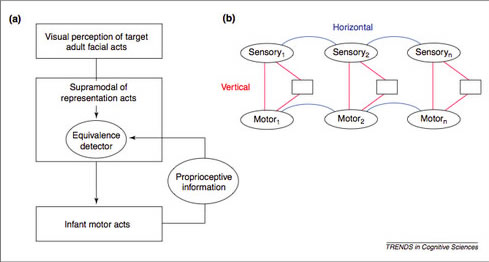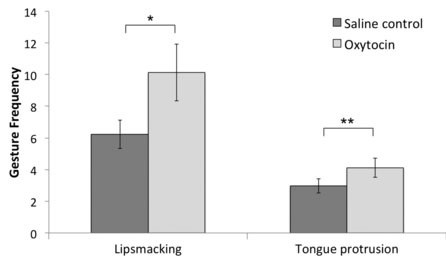Imitation in Primates
Biology 342 Fall 2014
Annelise Hill Yasemin Lopez
Mechanism
The Brain and Imitation:
The neural pathway used for imitation is not certain. In order for imitation to occur we do know that there has to be a neural pathway that translates observations into actions. Based on surveillance of brain activity in chimpanzees two theories of brain pathways involved in the behavior have been developed. One focuses on an innate ability to imitate while the other favors learning (Heyes, 2001).
Active intermodal matching (AIM)
AIM proposes that imitation occurs through a neuron system that functions from an individuals birth in which sensory inputs are automatically matched with motor functions for the same action (Jones, 2012). This theory accounts for infants imitating their mothers, or imitating their human researchers. This early expression of imitation suggests an innate ability to process movements of others and express them in a motor program, theorizing that the mechanism is innate (Heyes, 2001).
Associative sequence learning (ASL)
ASL proposes that imitation is a developed behavior; different imitations are learned over time. This theory proposes that links are made as individuals match motor representations with sensory representation, either the sight of their own action (like balling their fist) or seeing it reflected in another individual (like smiling) (Catmur, 2009). ASL differs from AIM because it suggests that imitation is based largely on learning and is experience dependent, as opposed to an innate pathway. It suggests that there are sets of bidirectional excitatory links matching sensory and motor representations of actions leading to the ability to imitate various actions and that these links are learned from experience overtime (Heyes, 2001).

Figure: Flow chart (a) shows the proposed neural pathway involved in Active Intermodal Mapping. Chart (b) shows the proposed Active sequence learning pathway involving bidirectional links. (Heyes, 2001)
Areas of the Brain Involved:
Functional magnetic resonance imaging has been used to locate the areas of the brain that are largely involved in imitation. A link has been found between the left inferior frontal gyrus (IFG). The areas that are active when observers are watching arm movements in order to later imitate them are cortical and subcortical regions that are known to be active during verbally instructed motor preparation and mental practice. This suggests that there is a direct link between movement perception and movement execution.
Hormones and Imitation:
In macaque monkeys imitation has been shown to be connected to oxytocin, a neurohypophysial hormone. Studies suggest that infants who more frequently imitate their researchers, those with more positive social interactions, are more likely to be sensitive to exogenous oxytocin. It is believed that interindividual differences in social-cognitive abilities may rely on neurobiological substrates mediated by oxytocin (Simpson, 2014).

Figure 2. Infants’ lip smacking (LPS) and tongue protrusion (TP) gesture rates in the imitation recognition task (imitation and still-face periods combined), nebulized with either saline or oxytocin. These data are averaged across time postnebulization (1 and 2 h after nebulization). There was a main effect of condition (oxytocin > saline control) [F(1,26) = 5.96, P = 0.022, ηp2 = 0.186]. Error bars reflect SEM. *P = 0.014, **P = 0.029. (Simpson, 2014)